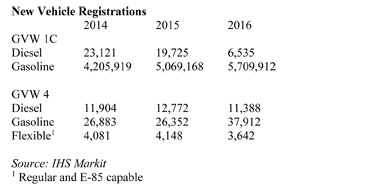Using Technology to Reduce Engine Idle
In the U.S., roughly 3 billion gallons of diesel fuel and gasoline are consumed each year by idling engines on medium- and heavy-duty trucks, according to Argonne National Laboratory (www.anl.gov). So, improving fuel economy – and thus lowering fuel expenses – without sacrificing performance is a must for utility fleets that often have to idle assets during working hours.
UFP recently reached out to industry experts to gain some deeper insight about this issue and discover possible idling solutions for utility fleet operations.
A Changing Landscape
For a long time, technology selections for medium-duty trucks were very limited, according to George Survant, senior director of fleet relations for NTEA – The Association for the Work Truck Industry (www.ntea.com).
But that’s changing. And while many fleets take a driver-behavior-based approach to idle reduction, one advantage of an equipment-based solution is that the change typically is good for the life of the equipment, said Survant, who also spent more than 25 years as a telecom fleet manager.
“We, as fleet operators, are becoming more sophisticated in our acceptance of new technology and sensitive to the need for better solutions,” he said. “Consequently, the market is producing more viable solutions that are made for an increasing number of applications.”
In Survant’s experience, each of the segments of a fleet may require different types of solutions to reduce idling based on vehicle type/mission. Idle reduction technologies for medium-duty trucks include air heaters, coolant heaters, waste-heat recovery systems and battery/auxiliary power systems, according to the U.S. Department of Energy (https://energy.gov/).
“For vehicles with extreme temperature swings – high or low or both – cab heating and cooling from stored energy may be a legitimate tool,” he said. “Stored energy solutions also may work for high-PTO-use equipment. With some of the new OEM products, where the manufacturer is increasing torque and horsepower with smaller displacement engines, a careful review of the legacy truck specification may reveal impressive opportunity for improvement.”
Additionally, Survant said some of the best opportunities for idle reduction come from vehicles built with stop-start technology. He noted that the “technology can be unsettling to the driver until they learn to trust the equipment’s restart capabilities, along with understanding the slightly different driving technique needed to take advantage of these capabilities.”
It is important to recognize that while some vehicles may share a basic description and upfit, not all of them will necessarily benefit from an idle mitigation strategy. For instance, “Think of an aerial unit that could use stored energy for PTO operations but does not deploy the aerial unit often enough to justify the cost of the mitigation strategy,” Survant explained.
Realizing Benefits
Washington-based Clark Public Utilities wanted to provide its fleet exceptionally reliable equipment, reduce its dependency on fuel and lower transportation emissions – in that order, said Paul Chamberlain, fleet services manager for CPU.
The company sought a solution that would not impede upon the work required of the equipment, but that would provide operators access to heat and air conditioning, offer programmable features, be cost-effective, and have the capability of managing numerous inputs and outputs.
Of CPU’s 265-unit fleet, 29 over-the-road vehicles have been upfitted with idle management systems. The company is currently using two different systems: GRIP Idle Management System by Canadian Extreme Climate Systems (www.gripidlemanagement.com) for light- and medium-duty equipment, and Zone Technologies’ OZONE TECH (www.zonetechnologie.com/en/products/idle-reduction-system/) for heavy-duty equipment. According to Chamberlain, CPU prioritized integration of idle management systems onto equipment that exhibited high levels of idling as well as high levels of mechanical failures due to idling.
The idle reduction module is designed to start and stop the engine within a controlled set of programmability values and ambient temperature. It can be integrated into both gas and diesel engine applications within the electrical system of any vehicle.
The results? “We are averaging about a 25 percent reduction within the trucks upfitted with idle management, with a fleet average of about 15 percent overall,” Chamberlain said. “Not all of it has been as the result of technology, but has been a combination of technology and employees making an effort to shut their vehicles off when they do not need to idle.”
Where to Start
If you’re wondering where to begin with an idle reduction strategy for your fleet, first and foremost, be clear about what you are trying to achieve.
“It is imperative to know what you need and are expecting from an idle management system,” Chamberlain said. “There are vendors more than willing to work with you toward a solution that will meet your needs.”
Survant shared similar advice: “Weigh the existing fleet performance and forecast the amount of improvement potential to the units you are upgrading to the new technology. Some segments of your fleet may only get a 2 to 3 percent reduction in fuel burned, but when evaluated against the cost of the mitigation strategy, even what appears to be a modest improvement has the potential to provide a solid return on your investment.”
Good techniques for addressing fleet engine idling include identifying the idle characteristics of your fleet by vehicle type, understanding the root cause of the high-idle conditions you need to address and finding good technology-to-mission matches to deploy anti-idle strategies.
“As more and more equipment goes into service with idle mitigation technology, every gain becomes a permanent improvement in your operation into the fleet’s future for the life of the new technology,” Survant said.
About the Author: Grace Suizo has been covering the automotive fleet industry since 2007. She spent six years as an editor for five fleet publications and has written more than 100 articles geared toward both commercial and public sector fleets.








